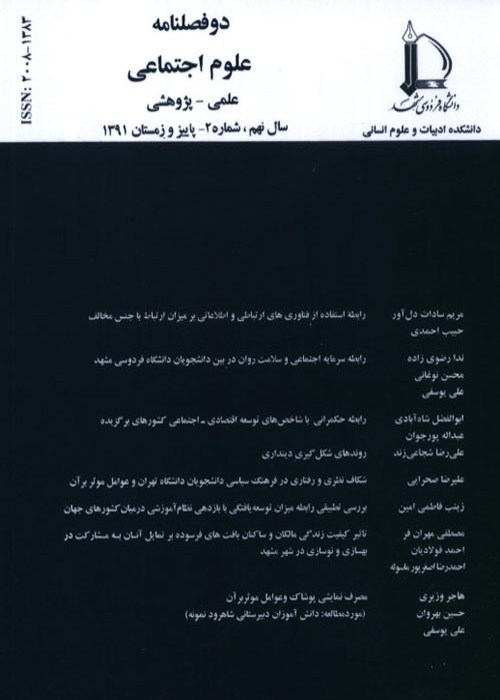Sociological Study of the Effects of Religiosity on Mental Health Using the Stress Process Model (A Case Study of University and Seminary Students in Qom, Iran)
Author(s):
Article Type:
Research/Original Article (دارای رتبه معتبر)
Abstract:
1. Introduction
Sociologists attempt to discover social patterns on the generation and distribution of mental health and disorders as they believe social structures of societies such as inheritance and biological features definitely restrict individuals’ behaviors. The stressful experiences leading to mental disorders could be associated with the social structures surrounding individuals as well as the position that they occupy in social structures. Accordingly, social structures can be classified into two general groups: the social stratification system (class, race, gender, ethnicity, and age) and social institutions (social statuses and roles) (Pearlin, 1989).In this regard, examining the social status and role of students who study at universities, seminaries and religious schools with the purpose of identifying their impacts on students’ mental health and disorders, can be considered an important subject in sociology. It appears that given the different social statuses and roles of university and seminary students, their diverse educational backgrounds in seminaries (religious sciences) and universities (nonreligious sciences) as well as being exposed to various stressors, examining the effects of the received stress by these two groups and understanding the moderating variables in this relation (social support and religiosity) could offer a valuable opportunity to observe the direct and indirect impacts of religiosity as a social variable on regulating stressors and, ultimately, the condition of their mental health and disorders.
2. Theoretical Framework
The theoretical model used in the present inquiry is Leonard Pearlin’s stress process model. Within the framework of sociological studies on mental health, this theoretical model is an attempt to describe and explain the causes behind the occurrence and prevalence of mental disorders resulting from stress, which itself is influenced by social environment. Pearlin et al. (1981) believe that social stress process could be considered a combination of three major conceptual realms including: 1) Stress sources (such as life accidents and life’s chronic pressures); 2) Stress mediators and moderators (such as social support, coping strategies); and 3) manifestations of stress (within a range of microbiological layers of stress to emotional manifestations and extrinsic behaviors). Subsequently, Pearlin (1989 & 1999) completed his social stress theory so as to incorporate in his model the “social context” in which the stress process takes place (Riahi & Rahbari, 2014). In line with the application of this theory, it could be stated that as university and seminary students occupy their particular different statuses in the former and the latter, playing their particular roles, they could be exposed to various stressors and tolerate different levels of stress (stress sources); this, in turn, could result in the students and seminaries’ suffering from a variety of mental disorders which could reduce their level of mental health (stress consequences). Nevertheless, the stressors related to the status and role of being a university/seminary student can be moderated through mediating factors (sources of coping with stress). In this study, religiosity and social support were examined and tested as the mediating and moderating factors, respectively, for the effects caused by the stresses of being a university/seminary student on the students’ mental health.
3. Method
The present inquiry is a quantitative study conducted as a cross-sectional research using the survey method. The total population of the study included the entire students (undergraduate or above) of various majors in Humanities studying at public, Azad, and Payam Nour universities in addition to seminary students (level two or higher) in Qom, Iran. Out of the total population of 56237, four hundred individuals were selected as the sample population using stratified sampling with disproportionate allocation.Standard scales were used in order to measure the independent and dependent variables of the study. Subsequently, Goldberg’s general health questionnaire containing 28 questions (GHQ-28), multidimensional scale of perceived social support (Zimet et al. 1988), life stress questionnaire (Thomas et al. 1993) , and religiosity evaluation model (Seraj Zadeh, 1998) based on Glock and Stark, (1965) (made compatible to Islamic religiosity) were employed to evaluate and operationalize variables of mental health, social support, stress, and religiosity.
4. Results and Discussion
According to the descriptive findings, 60.9% of respondents were identified as seemingly suffering from mental disorders (69.9% and 52.6% for university and seminary students, respectively), while 59.9% involved high levels of religiosity (36.7% and 81.8% for university and seminary students, respectively). The results obtained from path analysis using regression coefficients denote the highest general impacts of variables namely; stress (beta coefficient of 0.643), social roles of university/seminary students (-0.261), social support (-0.146), and religiosity (-0.077) on mental health, respectively. As a result, it can be predicted that the highest extent of mental health were observed in respondents who were less stressed, seminary students, received more social support, and more religious. 5. ConclusionAccording to the main hypothesis of the study based on Pearlin’s stress process theory, the occupation of social statuses by university/seminary students and playing the roles related to such statuses could, directly or indirectly (through mediator and moderator variables), result in differences regarding their levels of mental health. The results obtained in the present study which represent the difference between the respondents’ level of mental health and demonstrate a better mental health in seminary students compared to university students confirm the stress process theory; accordingly, when playing the social roles related to their social statuses, individuals (seminary students compared to university students) are primarily exposed to a lesser extent of stressors while having access to different extents of sources to cope with mental pressures (social support, esp. religiosity). In this case, i.e. receiving less stress on one hand and having access to more sources of coping with stress on the other have led to a reduction in seminary students’ vulnerability against mental pressures compared to university students, ultimately enhancing the former group’s extent of mental health.Keywords:
Language:
Persian
Published:
Journal of Social Sciences, Volume:15 Issue: 2, 2019
Pages:
133 to 172
magiran.com/p2019730
دانلود و مطالعه متن این مقاله با یکی از روشهای زیر امکان پذیر است:
اشتراک شخصی
با عضویت و پرداخت آنلاین حق اشتراک یکساله به مبلغ 1,390,000ريال میتوانید 70 عنوان مطلب دانلود کنید!
اشتراک سازمانی
به کتابخانه دانشگاه یا محل کار خود پیشنهاد کنید تا اشتراک سازمانی این پایگاه را برای دسترسی نامحدود همه کاربران به متن مطالب تهیه نمایند!
توجه!
- حق عضویت دریافتی صرف حمایت از نشریات عضو و نگهداری، تکمیل و توسعه مگیران میشود.
- پرداخت حق اشتراک و دانلود مقالات اجازه بازنشر آن در سایر رسانههای چاپی و دیجیتال را به کاربر نمیدهد.
دسترسی سراسری کاربران دانشگاه پیام نور!
اعضای هیئت علمی و دانشجویان دانشگاه پیام نور در سراسر کشور، در صورت ثبت نام با ایمیل دانشگاهی، تا پایان فروردین ماه 1403 به مقالات سایت دسترسی خواهند داشت!
In order to view content subscription is required
Personal subscription
Subscribe magiran.com for 70 € euros via PayPal and download 70 articles during a year.
Organization subscription
Please contact us to subscribe your university or library for unlimited access!



